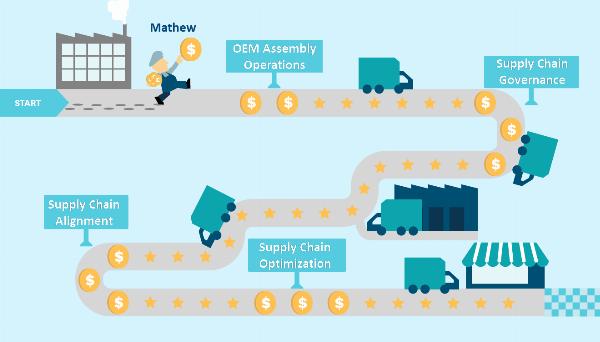 On-Page SEO Optimization – Fix Hidden Errors Killing Rankings!
On-Page SEO Optimization – Fix Hidden Errors Killing Rankings!
Role of Data Analytics in Shaping Aftermarket Strategies
Written by Robert Wilson » Updated on: June 17th, 2025

The aftermarket is constantly changing, and OEMs embrace data-driven decision-making and advanced analytics interpretation of enormous volumes of data so that OEMs can make much more informed and strategic decisions.
The use of data for making informed decisions and insights in the aftermarket context has been followed for a long time, especially in this complex market environment. This not only helps in providing better decision-making direction but also improves efficiency.
By using data, OEMs can foresee upcoming trends, choices, and challenges. With increasing access to and sophistication in data tools, it is time for OEMs to incorporate these methodologies to maintain a competitive advantage and succeed in the dynamic aftermarket landscape.
What Is Data-Driven Analytics?
Data-driven analytics is the decision-making process rooted in data analysis and interpretation instead of gut feelings and guessing. Data collection from different sources gets crunched using advanced tools and transformed into actionable insights eventually guiding business policies.
The Key Elements of Data-Driven Analytics Include:
1. Data Collection
Data collection involves gathering relevant, up-to-date information from sales records, feedback from customers, reports from any activity that could be operational, and most importantly, market trends.
2. Data Analysis
Techniques to find patterns, correlations, and trends in the data include statistical analysis and machine learning or artificial intelligence.
3. Actionable Insights
They should directly translate into good applications of the analyzed data into decision-making, which can directly impact business outcomes. Data from records of inventory is efficiently used in inventory forecasting. Efficient digital parts catalog is another great example of a data management software that helps in the collection of data and making decisions through actionable insights.
Ultimately, the sheer volume of data becomes actionable insights that can allow businesses to reduce their uncertainty and make better decisions in response to or in anticipation of changes in market conditions. For OEMs, such data-driven analytics could translate into increased operational efficiencies, customer satisfaction, and long-term competitiveness in the aftermarket.
What Are The Different Types of Analytics
There are four major types of data analytics in the content of the aftermarket, all of them are focused on achieving a specific goal that is supposed to improve decision-making and operations.
1. Descriptive Analytics
This type includes summarizing historical data for enhanced insights into past performance. For instance, the analysis of sales trends of specific parts or services by OEMs would mean knowing what happened in the past.
2. Diagnostic Analytics
This informs about the root cause of past results. In diagnostic analytics, OEMs can know the reasons for a large percentage of returns, recurrent service failures, or delayed supplies in any part of the supply chain, and this enhances the root cause analysis.
3. Predictive Analytics
This involves some kind of forecast required for a future event or trend. For instance, predictive analytics help OEMs to predict the breakdown of equipment much prior so that they may schedule their maintenance activities in advance and thus avoid costs on potential downtime.
4. Prescriptive Analytics
This could help in creating a suggested course of action by analyzing data-for instance, OEMs will use prescriptive analytics to optimize inventory management, suggest preventive measures, and improve service delivery.
Each type of analytics is uniquely useful in its way to support OEMs in making more information-based decisions while operating in the backend, saving costs and ensuring customer satisfaction.
Challenges and Ethical Considerations
There are several challenges associated with the use of data analytics in the aftermarket. Data analytics has proven to be a great tool for increasing aftermarket business, but it also presents several challenges and ethical concerns.
1. Data Quality and Accuracy
Flawed analytics or poor decision-making may result from basic data. Ensuring proper data quality is always of paramount importance in effective analytics, although getting clean, reliable data may prove to be quite a challenge.
2. Integration Issues
A lot of issues may occur in the integration of customer feedback data, sales records, and supply chains within one system. The OEMs may face problems aligning the various data streams into a common and holistic view. This is why data management and integration aftermarket software solutions are introduced to provide accurate, real-time information.
3. Privacy Issues
Capturing and analyzing data of both customers and operations creates more concern for privacy and data security. OEMs have to respect diverse data protection laws, like GDPR, and other compliance standards about proper management of personal data.
4. Analytics Biases
Algorithms may sometimes reflect biases inside the data and, in this way, produce discriminating results. OEMs must ensure the analytic tools don’t compromise on discriminative results and give unbiased insights.
5. Ethical Use of Data
OEMs must use data ethically and transparently to adopt the way customer data is collected, analyzed, and implemented. Misuse of data can damage the trust of customers and may even lead to legal consequences.
Achieving these challenges and ethical considerations becomes a highly important aspect of the responsible use of data analytics in the aftermarket industry.
What Are The Benefits of Making Data-Driven Decisions?
Analytics-supported, data-driven decision-making is the big advantage that OEMs can get in the aftermarket. Using analytics, OEMs have a more profound and detailed understanding of their operations. This leads to factual decisions that result in real improvements.
1. Operational Efficiency
Analytics help in optimizing processes such as inventory management and supply chain operations. OEMs can reduce overstocking and avoid shortages through demand patterns and stock-level analysis, saving much on costs.
2. Enhanced Customer Insights
Data analytics can provide very evident insights into customer behavior, preferences, and needs. OEMs can use such data for customized services, personalized solutions, and overall better customer satisfaction.
3. Predictive Maintenance
Analytics enables OEMs to predict equipment failures and needs for maintenance by analyzing historical data. In this way, OEMs can take proactive maintenance and avoid downtime with longer asset life.
4. Risk Management
With warranty analytics data, OEMs can identify threats such as warranty fraud, which is a problem in the supply chain. This can also help in preventing the cost-impact consequences.
Data For Business Growth
Analytics-driven decisions are essential for business growth as they provide companies with grounds to take more strategic and informed action and more effective ones. For example, through analytics, by looking at data from almost every source that could be garnered, like customer response, sales performance, and market trends, businesses can pinpoint opportunities to exploit for growth and optimize the business processes.
1. Market Expansion
It also provides insights into the market and expansion in that it tracks consumer behavior and emerging trends, thus enabling it to customize products and services tailored to address such market demands. This leads to better customer engagement, higher sales, and effective market expansion strategies.
2. Process Optimization
Operational data analysis helps businesses pinpoint inefficiencies and improve processes. For instance, bottlenecks in production or logistics can be pinpointed with analytics, which can thus reduce costs and improve productivity.
3. New Product Development
Data analytics provides the opportunity for insights into better servicing customer needs and preferences, helping enterprises innovate with new products or services that appeal to their target customers.
4. Risk Management and Decision Accuracy
Analytics reduces uncertainty with accurate, data-backed forecasts. Therefore, businesses can make calculated decisions without losing anything significant, providing sustainable growth.
Wrapping Up
An important enabler for OEMs to gain a foothold within the aftermarket market is data-driven analytics. Introducing descriptive, diagnostic, predictive, and prescriptive analytics to an OEM can improve efficiency in operations, enhance customer satisfaction, and ultimately predict future business trends.
However, still significant barriers exist, such as data quality issues, privacy, and ethical dilemmas, which OEMs must bypass for a competitive advantage. Analytics not only helps in making decisions but also fuels business growth as it extends across markets, processes, and innovations.
Note: IndiBlogHub features both user-submitted and editorial content. We do not verify third-party contributions. Read our Disclaimer and Privacy Policyfor details.
Copyright © 2019-2025 IndiBlogHub.com. All rights reserved. Hosted on DigitalOcean for fast, reliable performance.

















